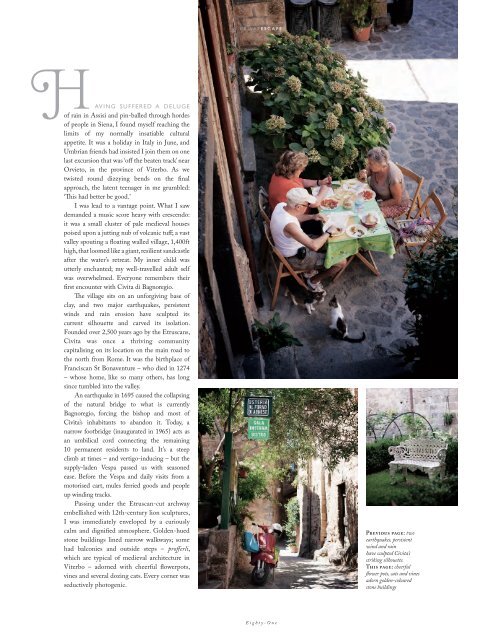Download - PrivatAir
Download - PrivatAir
Download - PrivatAir
You also want an ePaper? Increase the reach of your titles
YUMPU automatically turns print PDFs into web optimized ePapers that Google loves.
AVING SUFFERED A DELUGE<br />
of rain in Assisi and pin-balled through hordes<br />
of people in Siena, I found myself reaching the<br />
limits of my normally insatiable cultural<br />
appetite. It was a holiday in Italy in June, and<br />
Umbrian friends had insisted I join them on one<br />
last excursion that was ‘off the beaten track’ near<br />
Orvieto, in the province of Viterbo. As we<br />
twisted round dizzying bends on the fi nal<br />
approach, the latent teenager in me grumbled:<br />
‘Th is had better be good.’<br />
I was lead to a vantage point. What I saw<br />
demanded a music score heavy with crescendo:<br />
it was a small cluster of pale medieval houses<br />
poised upon a jutting nub of volcanic tuff ; a vast<br />
valley spouting a fl oating walled village, 1,400ft<br />
high, that loomed like a giant, resilient sandcastle<br />
after the water’s retreat. My inner child was<br />
utterly enchanted; my well-travelled adult self<br />
was overwhelmed. Everyone remembers their<br />
fi rst encounter with Civita di Bagnoregio.<br />
Th e village sits on an unforgiving base of<br />
clay, and two major earthquakes, persistent<br />
winds and rain erosion have sculpted its<br />
current silhouette and carved its isolation.<br />
Founded over 2,500 years ago by the Etruscans,<br />
Civita was once a thriving community<br />
capitalising on its location on the main road to<br />
the north from Rome. It was the birthplace of<br />
Franciscan St Bonaventure – who died in 1274<br />
– whose home, like so many others, has long<br />
since tumbled into the valley.<br />
An earthquake in 1695 caused the collapsing<br />
of the natural bridge to what is currently<br />
Bagnoregio, forcing the bishop and most of<br />
Civita’s inhabitants to abandon it. Today, a<br />
narrow footbridge (inaugurated in 1965) acts as<br />
an umbilical cord connecting the remaining<br />
10 permanent residents to land. It’s a steep<br />
climb at times – and vertigo-inducing – but the<br />
supply-laden Vespa passed us with seasoned<br />
ease. Before the Vespa and daily visits from a<br />
motorised cart, mules ferried goods and people<br />
up winding tracks.<br />
Passing under the Etruscan-cut archway<br />
embellished with 12th-century lion sculptures,<br />
I was immediately enveloped by a curiously<br />
calm and dignifi ed atmosphere. Golden-hued<br />
stone buildings lined narrow walkways; some<br />
had balconies and outside steps – proff erli,<br />
which are typical of medieval architecture in<br />
Viterbo – adorned with cheerful fl owerpots,<br />
vines and several dozing cats. Every corner was<br />
seductively photogenic.<br />
PRIVATESCAPE<br />
Eighty-One<br />
Previous page: two<br />
earthquakes, persistent<br />
wind and rain<br />
have sculpted Civita’s<br />
striking silhouette.<br />
This page: cheerful<br />
fl ower pots, cats and vines<br />
adorn golden-coloured<br />
stone buildings


